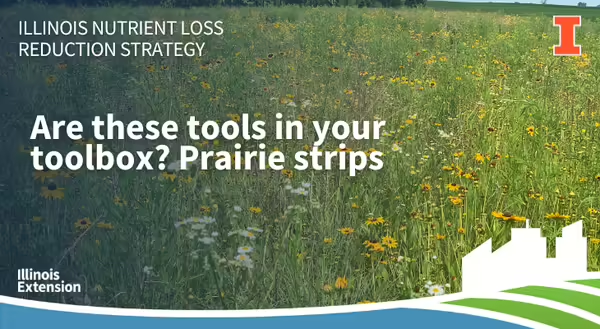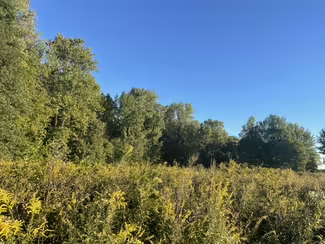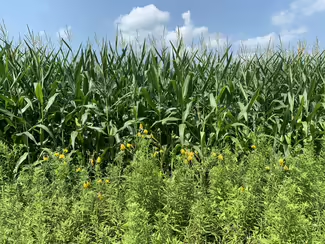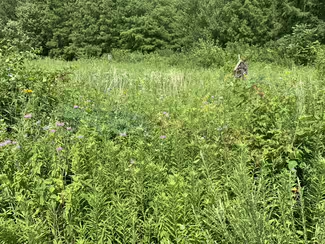
Prairie strips are notably not a very well-known conservation practice, despite their many benefits. Prairie strips are a conservation practice that uses strategically placed native prairie planting in agricultural fields. Prairie strips protect soil and water while providing habitat for wildlife. Paula Hingson, Assistant State Conservationist for Easement at NRCS and Conservation Reserve Program (CRP) program manager, and Dallas Glazik, with Pheasants Forever, shared their knowledge and experience using cover crops in an agricultural setting.
The scoop on prairie strips
Prairie strips are comprised of native perennial vegetation. They can be placed along field contours to reduce erosion, or around field borders for both erosion control and promotion of habitat diversity. The strips provide plant diversity for wildlife and beneficial insects, which in turn improves soil health from the increased diversity in root systems and microbial communities below ground. Glazik explains that Pheasants Forever supports prairie strips largely due to those beneficial insects. Within just a few years, it is possible for the need for insecticide to be completely eliminated. Prairie strips planted along contours reduce nutrient transport specifically, due to the active plant growth they provide.
Within the first year of being planted, farmers can see a 33% reduction in pest insects from the increase in bird species that the strips attract. It's noted that one barn swallow will consume approximately 850 insects per day. There is also a big growth in arthropods and predatory beetles.
Cost-share opportunities
Luckily, those interested in implementing prairie strips can do so through the CRP cost-share program. This is managed by the Farm Service Agency (FSA), and the NRCS provides technical assistance for seed mixtures and placement of prairie strips. Hingson explains that once landowners get their prairie strips established with the help of cost assistance, they receive further help from rental payments for up to ten years. The NRCS will continue working with landowners throughout the length of the contract to ensure proper management.
Prairie management comes with an array of options.
-
Prescribed fire is effective for woody vegetation and invasive species.
-
Interseeding can revitalize the area.
-
Light discing breaks up the sod layer and brings soil to the surface where the sun can re-germinate the seed bank. This can look like discing one-third of the strips at a time at a half-inch depth.
-
Chemical control is beneficial for controlling cool-season grasses and woody species.
Seeding advice
Glazik points landowners in the direction of the Pheasants Forever website, where seeding mixes are designed for CRP standards. He says it is important to hit the three blooming periods: early summer/late spring, mid-summer, and end of summer/start of fall. These milestones have the most impact for bringing in wildlife species, and the deep-rooted plants are extremely beneficial for infiltration and water control.
Landowner considerations
Hingson shares that prairie strips are particularly beneficial for land with a slope. If the strips are planted on a contour, they can:
-
break up crop rotation
-
provide diversity for wildlife and insects
-
slow soil erosion
-
improve water quality
They also show to be a good border practice for blocking out encroaching trees.
Glazik encourages farmers to think about a minimum 10% field size for the strips, as 10% is the critical point for nutrient reduction and wildlife benefits. The CRP has a cap at 25% of field size, so 10-25% is the ideal range. The strips should be planned out with the landowner’s GPS system to ensure they follow the same lines as equipment. Glazik welcomes landowners with questions to contact him. Farmers can reach out to their local FSA, Soil and Water Conservation District (SWCD), and NRCS offices for questions.
To hear the full interviews with Paula Hingson and Dallas Glazik check out the Illinois Nutrient Loss Reduction Podcast Episode 39.
ABOUT THE AUTHORS
Rachel Curry is an Agriculture and Agribusiness Educator for two Nitrogen Priority Watersheds (Flint-Henderson and Lower Rock River Watersheds) and is housed in the Galva office of the Henry, Mercer, Rock Island, and Stark Counties Extension Unit. Rachel earned a BS in Environmental Studies from Knox College and an MS in Environmental Science and Soil Science from Iowa State University with an emphasis on soil fertility. She is interested in sharing information on the Illinois Nutrient Loss Reduction Strategy and agricultural conservation practices through discussion and outreach.
Nicole Haverback is a Watershed Outreach Associate for two Phosphorus Priority Watersheds (Embarras and Little Wabash River Watersheds) and is housed in the Effingham office of the Clay, Effingham, Fayette, and Jasper Counties Extension Unit. Nicole earned a BS in Agriculture and Rural Policy Studies from Iowa State University in May of 2022. She is interested in sharing information on the Illinois Nutrient Loss Reduction Strategy and agriculture conservation practices through discussion and outreach.
Sam Henry is a Research and Extension Experience for Undergraduates (REEU) intern working with Rachel and Nicole during Summer of 2023. She is an Agricultural Engineering student at the University of Illinois. Outside of classes, she works with Dr. Rodriguez in his BioMASS Lab and learns about alternative agricultural methods in Illini Urban Farmers. She is in her third year and is passionate about the nexus of clean water, sustainable agriculture, natural resources, and sustainability.
ABOUT THE BLOG
At Illinois Extension, we’re working to improve water quality at home and downstream. Every month, our Watershed Outreach Associates will bring you stories highlighting agricultural conservation practices, current research projects and results, and from the field farmer interviews. The Nutrient Loss Reduction blog covers conservation practices recommended by the Illinois Nutrient Loss Reduction Strategy, timely updates, farm safety, and new decision tools to help farmers and producers reduce the nutrients leaving their field. Want to get notified when new blog posts are available? Subscribe at go.illinois.edu/SubscribeINLRS.



